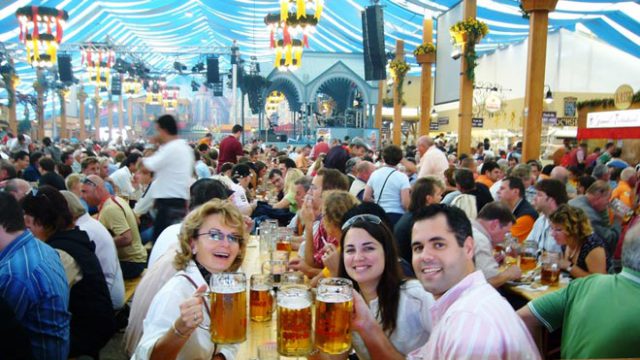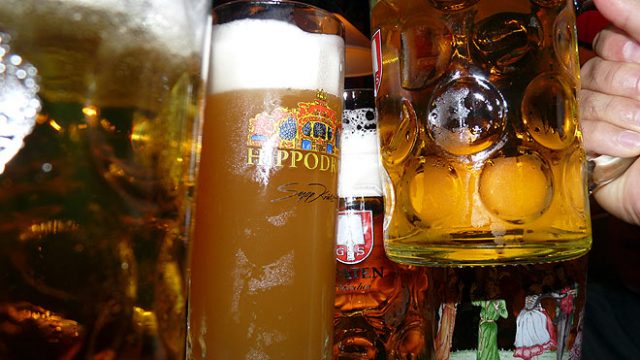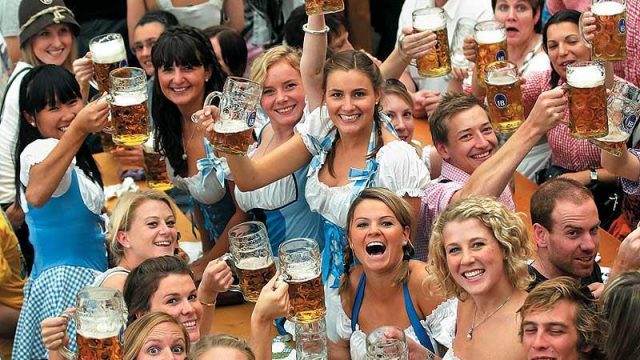A floating beer garden. Aboard a medieval wooden longboat, albeit with covert modern luxuries. Sailing down the
My preference for a sailboat over, say, a racy jet ski or a banana boat, has bemused many a fellow traveller. And beer, however craftsy, is not my beverage of choice. Nor was Siebnerin, the Biergarten ship, a replica of a medieval salt ship, a half Viking boat that proved to be able to slice water at considerable speeds. Still, as afternoon transitioned into dusk, and captain Fritz began deciphering the rather modern experience, it was hard to push aside those magical moments.

Call it a stream of unconsciousness, if you will, that led me to Regensburg when I was really looking out for the Danube. This was a former Big City, with all its trappings—wealthy residents who competed for ever grander reminders in the shape of built heritage, a waterfront that brought in the riches, a trade hub where multiculturalism flourished and drew in the crème de la crème. Officially established in 179 AD on the south bank of the river, fragments of Roman walls are still extant, and proudly shown off by the erudite local guide, Ulrike Unger. Indeed, as she led us up and down historic Regensburg, marvelling at the stunning façades, our views spanned centuries in close proximity.
Regensburg is located at the Danube’s northernmost point, on a flowing bend towards the beginning of the 2,800km-plus journey of this mighty river. The river made the city a trading hub, most importantly for salt, in the medieval period. Its golden era was ushered in by the construction of the Steinerne Brücke, or the Stone Bridge, in 1146 AD. The ‘miracle monument’ established a new trading route between Northern Europe and Venice, Russia and Byzantine, connecting to the Silk Road, and served as the model for other famous bridges, including the London Bridge. A closer look reveals not just a stone road, but also towers, gates, design flourishes, gables, figureheads and sculptures, technological marvels of their day.

Another highlight is the Cathedral, a Gothic masterpiece built over six centuries in conjunction with the ebbs and flows of the city’s economy. Regensburg became the permanent home of the Imperial Diet of the Holy Roman Empire, and is even now referred to as ‘Italy’s northernmost city’ due to its extensive historic monuments. The Adler-Apotheke, founded in 1610, is one of the world’s oldest pharmacies.

The Goldener Turm (Golden Tower), built in 1260, at 50m high, was the tallest structure around. St Emmeram’s Abbey, founded in 739, was at various points a monastery, library, abbey and finally a palace for the local ruling house. Exquisite sculptures, richly embellished tall buildings, dark, narrow lanes, imposing imperial palaces, patrician houses, impressive fortifications, mainly made between the 11th and 13th centuries, still define the city’s architecture. Such was the wealth that even then, most structures were made of stone and not timber, which would continue to be the norm for less well-off cities till centuries later.
Regensburg’s six-odd centuries of dominance ended with Napoleon’s march into Bavaria—leading to the first steps of what would become Germany. But old legacies die hard, and even in the 19th century, Bavarian ruler Ludwig decided to build a ‘hall of fame’ for Germans, called Walhalla, here. The inspiration was the Valhalla of Norse mythology; architecturally, it is an approximation of the Parthenon. A more modern analogy would be Hollywood’s Walk of Fame, only this is a huge monument with plaques and statues honouring the distinguished. And it is added to continuously. Qualifying criteria: you have to be German, have contributed to human knowledge immensely and dead for at least 20 years. The Walhalla is a little downstream from Regensburg, ideal for a beer-laden ride along the Danube.
The Danube still forms a crucial part of the city. Wide, braided and interspersed by islands, its banks are wooded beyond the city limits, making them ideal getaways. And yes, Regensburg is as much about being a fun, cool getaway. Don’t believe the Lufthansa ad currently repeated ad nauseam on television, especially the part where it says “Germans are different, always serious”.

Beer could be a one-word repudiation. But the region boasts a considerable culinary tradition as well. The flavours of the past come alive at Historische Wurstkuchl, established in 1135, which claims to be the world’s oldest sausage kitchen. Gorge on traditional finger-size sausages served with sauerkraut and sweet grainy mustard. Located adjacent to the Stone Bridge, just below what is today the Unesco Heritage Centre, its windows overlook the azure Danube. Do order the sausage platter for a once-in-a-lifetime experience of the sheer variety of sausage types.

A typical Bavarian meal features chunky sliced meat—usually beef, though veal or pork are common too, with broth. Traditional sides include knödel, tennis ball-sized dumpling spheres of bread and potato. Also common are fillings of bacon or pork belly, chopped onion, sauerkraut, pickles and mustard. Salty mega pretzels qualify only as a snack. Yes, it’s all highly calorific, and modern Germans can be seen running all over the place to keep themselves in shape! I definitely did get rounder around the middle. That Bavarian cuisine is distinct is perhaps reflected best in the Weißwurstäquator—literally, ‘white sausage equator’.
All of this is accompanied by beer quaffing, of course. Biergarten, or beer gardens, are at their largest and most famous in neighbouring Munich, but Regensburg holds its own too. Bierkellers are everywhere, and the city produces its own pilsners and dunkels. Regensburg reportedly has the highest concentration of bars in Germany! Ulrike had thoughtfully carried a sampling of the beers produced in Regensburg, and contrived to offer them in a cellar dating back to Roman times during our walk.

Beer has a special significance this year as Germany is marking 500 years of Reinheitsgebot, or the Purity Law, by which it decreed that the only ingredients to be used to make beer were water, barley and hops. Yes, women brewing beer would often (only perhaps inadvertently) put all kinds of herbs, often poisonous, or even sand and glass, to a lesser to their menfolk!
But Regensburg, like other parts of Germany, is witnessing what for some is beer heres—craft beer. Proponents of the latter are a vociferous and persuasive lot, though, and by tweaking the brewing process, are marketing beer that is not meant to gulped by the gallon in a beer hall in testosterone-laden rivalries, but savoured a la fine wine. Fritz uncorked four distinct craft beers from a local label called Spital, while Ulrike offered four Salutaris. Daniela Wiese of the local tourism body pointed out that labels like these are not yet household names even in Germany but are growing in popularity.
As the Siebnerin sailed past luxury river cruise liners, headed to Vienna, Bratislava, Budapest and the Black Sea, it became easier to realise why this was such an important port, thousands of kilometres inland. Teeming with tourists in summer, its lively cultural scene includes theatre, dance, concerts and festivals, the biggest of which are the Volksfest and the Bürgerfest (no, not celebrating hamburgers but citizens!). A university town, its nightlife is buzzing with life and welcoming. Pace yourself, I would urge.

The city has spread beyond its historic boundaries. The site of a Messerschmitt Bf 109 aircraft factory and an oil refinery during World War II, Regensburg was heavily bombed, and revived only well into the second half of the 20th century. Siemens and BMW led a procession of corporations who set up plants here. Alongside came a renewed pride in the city’s unique past, which includes the house of Oskar and Maria Schindler, a crucial refuge during the war. With its manifold and distinct treasures, Regensburg could well be Germany’s best-kept secret. And best savoured slowly.
The Information
Getting There
Lufthansa flies out of five Indian cities. A return flight from Delhi to Munich, the nearest large airport, costs approx. ₹35,000. Munich is about an hour’s drive away from Regensburg via A9 and A93.
Visa
As part of the Schengen area, Germany follows the common rules. The visa form is downloadable (vfs-germany.co.in) and the turnaround time is about three to four days on average.
Currency
Like most of Europe, you will need euros to get along in Germany. Cards are commonly accepted. €1 = ₹75
Where to Stay
In a heritage city, it’s best to stay at a historic hotel. I know companions who have wanted nothing more than the predictability of a regular business hotel after pottering about in ruins all day. Regensburg offers both types, and hostels too. Heritage buffs should head to Goldenes Kreuz (from €130 doubles; hotel-goldeneskreuz.de). Its nine rooms each bear the name of a crowned head, and are still fit to receive them. Or try the Bischofshof am Dom, a former bishop’s residence converted to an opulent hotel (from €155 doubles; hotel bischofshof.de). For those who prefer contemporary lines and French windows, there’s the Best Western Premier Hotel Regensburg (from €180; bestwestern.de/hotels/Regensburg), a little outside the historic area.
Where to Eat & Drink
Well, the first stop has to be Historische Wurstkuchl, established in 1135, with a good claim to be the world’s oldest sausage kitchen. Younger by a couple of centuries is Dicker Mann, for the traditional meal of roulade, knödel and wursts, quaffed down with beer, of course. Most global cuisines are also well represented here, especially Italian. There are a number of Indian restaurants too, more than enough for you to make your own ‘Top 5’ list!
What to Buy
For a smallish town, its retail is quite diverse, from leading global and German brands to local boutiques. For German brands, explore the huge, multi-level bookshop Bücher Pustet, even if most of the stock is in German. But neat and artsy and welcoming! Or TK Maxx for regular German clothing. Then there is Selmair, nominally a toystore, but whose quirky collection includes a dizzying array of knick-knacks any well-adjusted adult will love. Another irresistible boutique is Schau Hi, literally ‘look closely’, especially for paper craft. Try Händlmaier’s Senf, or sweet mustard—available in multiple flavours. I loved the mango flavour, but there’s raspberry, cranberry, strawberry and a hundred others to choose from!
beer garden
Biergarten
City Breaks





